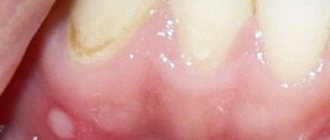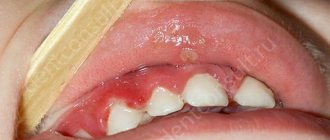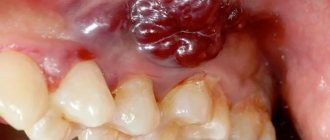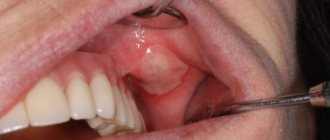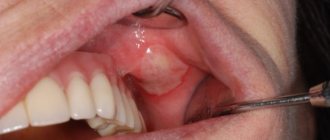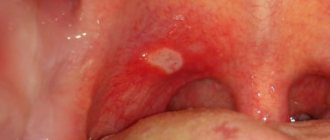One of the most common diseases associated with damage to the mucous membrane in the human oral cavity is stomatitis, which occurs in approximately a quarter of the entire world population. Children are most susceptible to the disease, the development of stomatitis in the mouth is accompanied by severe symptoms and requires immediate medical attention. But even among adults, stomatitis is not such a rare occurrence.
Therefore, even if you have never encountered the formation of painful ulcers on the palate, mucous membrane, throat or tongue, it will still be useful for you to know what stomatitis is, how it manifests itself, and most importantly, how such a disease is treated with medications . Dentistry "LeaderStom" will tell you about this, as well as how to prevent the occurrence and development of the disease through preventive measures for the hygiene of the human oral mucosa.
Stomatitis: what kind of disease is it, the mechanism of appearance of stomatitis ulcers
Scientists have not yet fully studied the mechanism by which stomatitis occurs on the mucous membrane in a person’s mouth. The manifestation of symptoms of the disease is associated with the specific reaction of a person’s immune system, which he exhibits in relation to irritants present on the mucous membrane of the mouth.
Bacteria, fungi, viruses and other microorganisms act as irritants. Normally, they are always present on human mucous membranes in one quantity or another. But when a person’s immunity is weakened, or other reasons provoke an increase in the number of microorganisms and the development of infectious diseases in the mouth (staphylococcal, streptococcal, candidal, etc.), this fact can trigger a stomatitis reaction.
Ulcers on the human mucosa, which are stomatitis in nature, are formed as a result of the fact that lymphocytes (white blood cells of the human immune system) begin to attack molecules that they cannot recognize. This reaction of the body is similar to that which occurs in the case of organ transplantation. As a result of such a lymphatic attack, stomatitis ulcers are formed on the oral mucosa, which usually go away on their own in one to two weeks without scarring.
Folk remedies for the treatment of ulcers on the palate
For rinsing, you can use thyme herb, brewed in boiling water, waiting until it cools to room temperature.
There are many traditional medicines that can relieve pain from wounds on the palate or help relieve inflammation:
- Dilute 1 teaspoon of salt and 1 teaspoon of soda in a glass of boiled warm water. Rinse your mouth with this solution 3 times a day.
- Dilute 2 teaspoons of calendula tincture in a glass of boiled water, rinse 2 times a day.
- Use freshly squeezed carrot juice diluted with water for rinsing 3-4 times a day.
- Grate raw potatoes on a fine grater and use the resulting pulp as a lotion for canker sores.
- Many people find that smearing ulcers with honey helps.
- One of the folk recipes suggests using the following option: you need to mix half a glass of milk with 1 egg yolk and a spoonful of honey. Mix the mixture well until smooth, then wrap your finger in a clean sterile cloth or bandage, dip it in the mixture and wipe the wounds. It is enough to wipe 3-4 times a day for 3 days.
It should be remembered that you should not get too carried away with folk remedies. With their help, you can relieve symptoms, relieve minor inflammation, or help the mucous membrane regenerate faster. The search for and treatment of the main cause of ulcers on the palate should be carried out by a specialist.
Types of stomatitis, causes and symptoms of the disease
Based on the peculiarities of the mechanism of occurrence, stomatitis manifests itself not only as a separate disease, but also as a concomitant sign of the presence of infection in the human body. Depending on what mechanisms provoked the appearance of stomatitis ulcers in the mouth of a child or an adult, various types of stomatitis disease are distinguished.
Types of stomatitis:
- Aphthous stomatitis.
This is a common form of the disease that occurs in humans at any age. It appears in the form of yellow-gray ulcers (ulcers) surrounded by a red halo. Oral ulcers occur in groups or singly; they hurt and cause discomfort to a person. - Herpetic form of the disease.
This stomatitis reaction develops against the background of a herpetic infection in the human body. Herpetic stomatitis appears in the form of painful small blisters on the oral mucosa, which are located in groups. Such bubbles burst after 3-4 days. The herpetic form of the disease in both children and adults is accompanied by fever, gingivitis develops on the mucous membrane in the mouth, and a person’s saliva becomes viscous. To treat the disease, the doctor usually prescribes the drug acyclovir to the patient. - Vesicular stomatitis.
In this case, a person with such a disease is contagious, since the causative agent of the disease is an RNA virus. In order to avoid infection, the patient’s personal belongings should be disinfected and separate utensils and personal hygiene products should be provided. - Allergic stomatitis reaction.
The disease occurs due to allergens entering the human body, to which it reacts by forming stomatitis ulcers. Allergic substances enter our body with food or drinks. Foods such as citrus fruits, red berries (strawberries, raspberries), tomatoes, peanuts, chocolate or cereals (since they contain gluten) can provoke an allergic reaction, the development of stomatitis and the formation of ulcers on the mucous membranes of a person’s mouth. - Traumatic stomatitis.
The occurrence of the disease is associated with injuries to the mucous membranes in the human mouth. They appear when a person eats rough food or drinks hot drinks. In addition, an adult or child can simply bite their tongue or scratch an area of the oral mucosa, and this will provoke a stomatitis disease. - Catarrhal stomatitis.
This form of the disease develops if a person does not follow the rules of oral hygiene: neglects daily brushing of teeth, rinsing, and flossing.
Only a doctor can diagnose one or another form of stomatitis disease in an adult or child. Do not try to do this yourself at home, studying photos from the Internet, and prescribe treatment for yourself. Each case is individual, so if you suspect stomatitis in the mouth, you should seek advice from a dentist or therapist. Competent doctors from the LeaderStom network of dental clinics will help you cope with the disease and cure wounds on the oral mucosa, palate, throat and tongue.
Stomatitis in a child: symptoms, causes
The description of stomatitis in a child deserves special attention. The specificity of stomatitis that occurs in the mouth of a young child is that the disease is a consequence of a weakened or not fully formed immune system. Therefore, the stomatitis reaction manifests itself clearly and the course of the disease is accompanied by severe symptoms.
Symptoms of stomatitis in a child:
- The oral mucosa turns red and swelling appears.
- Characteristic stomatitis ulcers form in the mouth, which are located either singly or in groups. The localization of ulcerative formations during stomatitis in a child is different: wounds and blisters appear on the tongue, on the palate, mucous membrane or in the throat. The nature of the lesions depends on the form of the disease and on what factors triggered the reaction (infections, allergies, vitamin deficiency, etc.).
- The development of stomatitis in the baby’s oral cavity is accompanied by an increase in the child’s body temperature (up to 38-39 degrees).
- The baby’s submandibular lymph nodes increase in volume and become painful on palpation.
- The child becomes lethargic, drowsy, capricious and whiny.
The baby has a hard time suffering from stomatitis in the mouth, and this is a lot of stress for the young body, not to mention the fact that the disease worsens the child’s appetite and disrupts the child’s sleep pattern. Therefore, if you notice the formation of ulcers in the mouth of your daughter or son or identify other symptoms of stomatitis, immediately show your child to a doctor (dentist or therapist).
Studying pictures and photographs of other children with oral stomatitis on the Internet is pointless; you will only waste your time and may come to the wrong conclusions. The doctor will help you understand the reasons that provoked the development of stomatitis in the child’s mouth and prescribe effective treatment for stomatitis.
How to treat wounds on the palate at home?
The most important thing to correctly determine the method of how to cure ulcers on the roof of your mouth is to determine the cause of this pathology. Only after identifying the root causes can you choose the most appropriate treatment. There are two types of treatment for this disease: medication and folk medicine. Let's look at each of them in more detail.
Drug treatment
It should be noted here: the prescription of medications to eliminate ulcers in the oral cavity should be carried out exclusively by a dentist.
Since only a professional doctor is able to determine the exact etiology of the disease and, based on this, prescribe the necessary medications.
We propose to briefly familiarize yourself with some drugs and means that can eliminate both the disease itself and its consequences.
- Antibiotics. Most often, this class of medications is prescribed when the disease is severe. The duration of treatment and the type of such medications are selected strictly individually.
- Two percent gel Xikain. Reduces painful manifestations and successfully fights pathogenic and inflammatory microbes, which helps wounds and ulcers heal in the shortest possible time. The use of Xikain gel is strictly contraindicated for children under six years of age. The reason for this is the presence of components harmful to the child’s body in this medication.
- Medicinal ointments. A very well proven remedy is Benzocaine ointment. Having an anti-inflammatory effect, this ointment can quickly eliminate inflammation in the mouth. This product contains analgesic components, so it is recommended to use it in the presence of pronounced pain.
- Benzocaine can cause an allergic reaction, so it is not recommended for children to treat ulcers. For them, you can use, for example, an ointment like Kamistad.
- Analgesic injections. The only really significant advantage of this type of drugs over others is the speed of action on the affected areas of the oral cavity, which makes it possible to urgently eliminate pain syndromes, especially with open ulcers, when the pain is felt most acutely. However, injections are completely ineffective in eliminating the causes that provoked the appearance of wounds inside the oral cavity.
Traditional methods
There has long been a great variety of folk methods for treating inflammatory processes in the oral cavity. Very often, such remedies are very, very effective and help make the healing process much shorter and more effective.
Let's look at a few examples of such effective remedies from the collection of folk wisdom.
- Rinsing the mouth with a salt-soda solution. It couldn’t be easier to prepare: one teaspoon of soda and salt are dissolved in two hundred grams of cold boiled water. Rinsing is done three times a day.
- Rinsing the mouth with a solution of pharmacy calendula tincture (two teaspoons per two hundred milliliters of warm boiled water). Rinse twice during the day.
- Gruel of finely grated potatoes. Applying such lotions very effectively relieves inflammation and accelerates the recovery and healing processes.
- Rinse your mouth 3-4 times during the day with freshly squeezed carrot juice, slightly diluted with boiled water.
- A very effective way to eliminate wounds on the palate and other parts of the mouth is to lubricate the affected surfaces with natural honey. This procedure will especially appeal to young children.
- Another very effective folk recipe for treating wounds on the roof of the mouth is the following remedy: mix one hundred grams of warm (preferably homemade) milk, one teaspoon of natural honey and one chicken egg yolk. Wipe the affected areas of the mouth with the resulting mixture three or four times a day. This is done using sterile gauze or a bandage wrapped around a finger and soaked in the above mixture. The course of such procedures should be carried out for at least three days.
Which people are at risk for stomatitis?
As already noted, children are primarily susceptible to stomatitis, since their immune system is just learning to fight infections and diseases and respond to irritants appropriately. Therefore, if, with timely consultation with a doctor and proper treatment, your baby still chronically develops stomatitis in the mouth, then perhaps the reason is due to age, and over time these problems will disappear.
But besides age, there are other factors that increase the risk of stomatitis ulcers in a person’s mouth. They are associated with various reasons, some of which we have already named when characterizing the types of stomatitis, but now we will try to specify each factor separately.
Those at risk for possible development of stomatitis include:
- People with a hereditary predisposition to the disease. Scientists have proven that the likelihood that stomatitis will develop in a person’s mouth (on the palate, mucous membrane, throat or tongue) increases if one or both parents have ever encountered similar problems. The best way out in this situation is to follow the rules of oral hygiene and take vitamin and immunomodulatory complexes as prescribed by your doctor.
- People with current somatic diseases. Quite often situations arise when stomatitis chronically develops in a person’s mouth without any obvious reason. During a complete examination of the body of such a person, any diseases are usually revealed, in particular, diseases of the gastrointestinal tract (giardiasis or helminthic infestations). Parasites, while in the body, may not manifest themselves in any way and not bother a person for years, but they reduce his immunity and prevent resistance to infections and other diseases. In this case, in order to get rid of stomatitis in the oral cavity, a person should undergo a course of treatment that will allow him to get rid of other concomitant diseases.
- People with reduced immunity. Human immunity is reduced not only by somatic diseases, but also, for example, by factors such as stress. Therefore, if you have a hard job or tense family relationships, this can cause chronic stomatitis, localized on the oral mucosa. In addition, frequent occurrence of ulcers in a person's mouth may indicate more serious problems with the immune system caused by a disease such as AIDS. Therefore, in this situation, a person is recommended to get tested, undergo a full examination of the body and get plenty of rest.
- People with bad habits. Bad habits such as alcohol, smoking and drug use can cause stomatitis and the formation of painful ulcers in the mouth. The fact is that such a lifestyle weakens the immune system and undermines human health. In addition, cigarette smoke and alcohol create favorable conditions in the oral cavity for the development of bacteria, viruses and fungal infections, which provoke the appearance of stomatitis ulcers on the human mucosa.
If you have seen photographs of people with stomatitis in the mouth, then you have probably noticed how unattractive this disease looks, not to mention how much discomfort it causes to a person. Therefore, if you are at risk for the possibility of developing stomatitis ulcers on the mucous membrane, palate, throat or tongue, then you should take measures to reduce the chances of getting stomatitis: quit bad habits, undergo a course of treatment for somatic diseases, increase your immunity and take vitamin complexes. But these measures should be taken only after consulting a doctor.
Why do wounds appear on the roof of the mouth?
Among the variety of causes that provoke the occurrence of wounds (ulcers) on the roof of the mouth, special attention should be paid to factors that can be divided into three categories.
Oral diseases
These common oral diseases include:
- Gingivostomatitis of necrotic type. The development of this disease is facilitated by oral injuries, weakened immunity, hypothermia, lack of vitamins, and the presence of allergic stomatitis. The gums, tonsils, palate, cheeks and tongue are affected. With this disease, the wounds may have a yellow or greenish coating, which causes an unpleasant odor from the oral cavity. Shallow wounds have uneven outlines. Very often, with this disease, the appearance of wounds is accompanied by minor bleeding. The treatment process must necessarily take place in a hospital setting and with the help of drug therapy.
- Herpetiform stomatitis. This disease is characterized by the appearance of sores very similar to herpes sores. In this case, damage to the palate and tongue occurs. The course of the disease usually takes no more than a few days. However, if the wounds do not heal on their own within seven days, you should definitely contact a specialist.
- Necrotizing periadenitis. The initial stage of this disease is characterized by the appearance of small compactions, which after some time become wounds (ulcers). The localization of the disease covers the lips, palate, cheeks and tongue. This causes difficulty while eating and talking.
- Recurrent stomatitis. The localization of wounds and ulcers in this disease covers the palate, the area around the lips, cheeks, and also the tongue. The disease is characterized by the presence of pain when eating, as well as a feeling of discomfort in the mouth. Treatment of this type of stomatitis must begin immediately when the first nonspecific symptoms appear.
- Oral tuberculosis. The course of this disease is characterized by the formation of ulcers (wounds) affecting the entire oral cavity, including the cheeks and surface of the tongue. There is no pain during the formation of such ulcers, but over time the ulcer can grow. During this type of tuberculosis, the wounds are not deep, but have a loose structure. Often the formation of wounds, as with necrotizing gingivostomatitis, is accompanied by bleeding. The wounds have uneven outlines. Treatment of this disease should take place exclusively in a hospital setting and under the close supervision of medical personnel.
Treatment methods for stomatitis
Local treatment of stomatitis involves treating ulcers on the palate, tongue, or other areas of the oral mucosa with antiseptic agents. If stomatitis ulcers appear in the throat, the patient is prescribed gargling with an antiseptic solution or medicinal herbs.
General therapy for the disease includes drugs that are aimed at eliminating the causes of stomatitis in the mouth: antibiotics (for a bacterial infection), antiviral drugs (for example, acyclovir for herpetic stomatitis in the mouth), antifungals (if the cause of stomatitis is a fungus of the genus Candida or what -other), antihistamines (for allergic stomatitis or to relieve swelling during the inflammatory process), etc.
For prevention, increasing the defenses of the human body and in order to prevent complications and the development of chronic stomatitis, the patient is prescribed immunomodulatory agents and vitamin complexes. To relieve pain and reduce fever during stomatitis, doctors use painkillers.
The closure and disappearance of stomatitis ulcers with appropriate treatment of stomatitis disease and inflammation that occurs in the human mucosa usually occurs within 1-2 weeks, but you should take medications prescribed by your doctor strictly within the course. The fact that you felt better and stopped experiencing pain and discomfort due to stomatitis in the mouth does not yet indicate that the disease has been cured.
Strictly follow all the doctor’s recommendations and do not try to cure stomatitis yourself, using the advice of friends or photographs and recipes for preparing medicinal potions found on the Internet. At best, you simply will not achieve the desired effect, and at worst, you will increase the symptoms of the disease.
Treatment
If wounds on the palate appear as a result of mechanical damage, then no special measures should be taken.
The only thing is to eliminate the cause of their formation, that is, avoid foods with sharp edges, brush your teeth more carefully, take a break from eating sour, salty and hot foods. The epithelial tissues will renew themselves, and the palate will return to normal.
You can rinse your mouth with a collection of medicinal herbs such as chamomile, sage, calendula.
Treatment of aphthae caused by some diseases of the body must be carried out in three directions:
- Eliminating the cause of ulcers.
- Local treatment of ulcers, their permanent treatment.
- Relieving pain.
To eliminate the causes, you must first increase your overall immunity.
The doctor may prescribe general health-improving medications and vitamin-mineral complexes. To eliminate swelling, antihistamines are prescribed at the discretion of the specialist. If the wounds cause severe discomfort, painkillers containing paracetamol or ibuprofen are used.
In case of acute pain, before contacting a specialist, it is possible to use lidocaine in a spray. If the cause of aphthae on the palate is a disease such as candidiasis, the doctor will prescribe antifungal drugs, for example, Diflucan or Flucostat.
If the cause lies in herpes, antiviral drugs are used, for example, Zovirax or Acyclovir.
Ulcers caused by bacterial infections require more serious treatment with antibiotics of various groups.
Aphthae that appear against the background of tuberculosis, syphilis and other infections are treated with appropriate anti-tuberculosis, anti-syphilitic and antiviral drugs.
For local treatment of ulcers, doctors usually prescribe rinsing with antiseptic solutions (for example, chlorhexidine solution or miramistin). Rinsing with pharmaceutical herbs has also proven to work well. Levomekol can be used as an ointment.
Acute and chronic stomatitis, what is the difference?
There are two forms of stomatitis disease: acute and chronic. For the first time, stomatitis usually manifests itself in an acute form, characterized by the sudden appearance of ulcers on the palate, mucous membranes in the mouth, tongue or throat of a person. The ulcers hurt and cause discomfort when talking or eating.
Acute stomatitis goes away on its own after 7-10 days, even if it is not treated, but in most cases the disease returns in a chronic form. This means that a person develops stomatitis ulcers in the oral cavity from time to time throughout his life. In order to prevent the transition of stomatitis disease from an acute to a chronic form, a person should undergo a course of treatment for the disease at the initial stage. It is very important that a plan and methodology for combating stomatitis in the patient’s mouth is developed by a competent and competent doctor who could take into account all the factors that could provoke this disease and get rid of them.
The LeaderStom clinic invites you to diagnose stomatitis and undergo a course of effective treatment under the supervision of the institution’s experienced dentists. Our doctors know modern methods of combating this disease in patients of different ages and are able not only to solve the existing problem, but also to give valuable recommendations for further oral care in order to prevent the occurrence of stomatitis ulcers on the mucous membrane, palate, throat or tongue of a person again .
When to contact a specialist
It is necessary, however, to note that, despite the apparent effectiveness of using traditional methods of treating wounds in the mouth, still at the first signs of the appearance of ulcers, wounds or other, even the most minor, foci of inflammation in the mouth, it is necessary to immediately contact a dentist in order to obtain a qualified consultation and effective, timely and professional treatment.
Advanced diseases that have become chronic can cause various kinds of complications and are much more difficult to eliminate than those detected in time.
